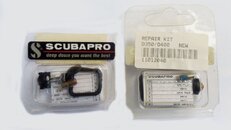As Axel said, 11.012.045 is the current service kit for the D350 and D400.
The 11.012.040 was a kit for the D300, D350 and D400 which included just the seat. Back then two kits were sold, one with the seat (11.012.040) and one with the whole poppet which includes the seat (11.012.041).
View attachment 891286
The current 11.012.045 for the D350 and D400 includes the whole poppet, just like the 11.012.041 did back then. As far as I'm aware, ScubaPro does not have a kit with only the seat anymore. I wonder if too many people broke things on the small poppet assembly to make them just sell the whole poppet and be done with it.
View attachment 891287
Depending on the price and condition of your poppets, just buying the kits with the seat in them instead of the whole poppets may make sense for you.




